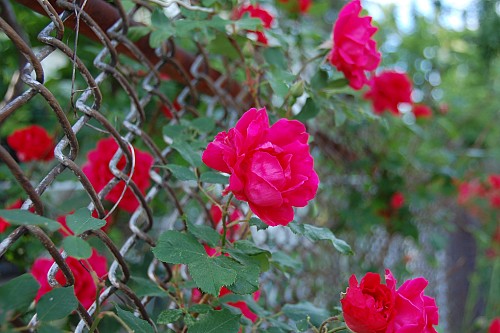Add Charm to Your Fence with Climbing Plants
 Flower lovers of the world, unite! If you believe that there is no such thing as too many blossoms, chances are you already have a garden (and perhaps a pergola, balcony, or deck) that is overflowing with bright posies ... yet you still urgently want room for more. So why not start some plantings that will cover your fence with color? Flowery lcimbing plants will add that something extra to a charming traditional wooden picket fence or soften even the severest chain link fencing.
Flower lovers of the world, unite! If you believe that there is no such thing as too many blossoms, chances are you already have a garden (and perhaps a pergola, balcony, or deck) that is overflowing with bright posies ... yet you still urgently want room for more. So why not start some plantings that will cover your fence with color? Flowery lcimbing plants will add that something extra to a charming traditional wooden picket fence or soften even the severest chain link fencing.
Here are 5 favorite climbing plants.
Rose
The rose is a universal favorite in almost any garden setting, so it is a natural to adorn your fence. Although you will need to put in some initial effort (and perhaps a few nails or screws attached to the fence’s support rails) to train a young rose to climb in the direction you’d like, the upside is that these climbing plants won’t dig in to your fencing as many true vines will, thus making them safe to use on any type of fence installation. Another upside, of course, is the amazing abundance of rosebush colors and scents there are to choose from.
Virginia Creeper
Virginia creeper is fantastic for its ability to thrive in a variety of soil conditions and amounts of light. Its five-pointed leaves are normally a medium green color, but transform to a stunning shade of crimson in the fall. To give them a headstart as fence cover, attach young Virginia creeper plants to your fence with plant ties. Once they're established, they will grow rapidly. In fact, you’ll need to prune back their leaves every spring, as well as occasionally scraping their aerial roots out of your fence’s nooks and crannies if the fencing happens to be made of wood.
Wisteria
One of the most spectacular fence-climbing plants is wisteria, which produces grapelike clusters of lovely white, purple, lilac, or pink blossoms … eventually. Wisteria is notorious for taking its sweet time to acclimate to a new setting. It’s also somewhat persnickety about receiving a fair share of sun, careful pruning, oh and by the way, go easy on the nitrogen, could you? Once it does produce flowers, though, we’d have to say the fragrant results are well worth the effort. Plant wisteria next to a vinyl or metal fence only, since it can easily damage the structure of wooden fencing.
Morning Glory
The morning glory is a fast growing annual which can reach 15 feet in a single season. Sow morning glory seeds in a 6"-deep trench, with a scaffolding of string to guide the young plants up your fencing as they sprout. They love sunlight and warmth, so position them beside a fence with a sheltered south or west exposure – and be sure to wait until your soil has warmed up to a temperature of at least 65 degrees F. Your morning glories will reward you with a display of blue, purple, magenta, pink, or white flowers that “magically” open with the sun’s early rays.
Honeysuckle
Honeysuckle is especially well known for its sweet scent, but its pretty, dainty blooms also will add a great deal of appeal to your fence, in shades ranging from palest white through gorgeous golds, dainty pinks, and deep reds. This perennial prefers sun, but will tolerate partial shade. Plant it in early spring and attach the growing shoots to your fence with stretchy ties (such as strips cut from worn-out T-shirts) that won’t harm the tender young branches. Be prepared for plenty of visits from butterflies and bees.
Laura Firszt writes for networx.com.
Updated December 3, 2018.
Looking for a Pro? Call us (866) 441-6648

Fencing Average Costs
Fence Contractors Experiences

Tree Removal For The Last Part Of A Poor Old Mulberry

Careful, Professional Tree Service Removes A Huge Norway Maple



